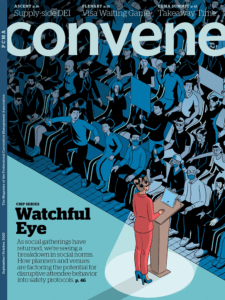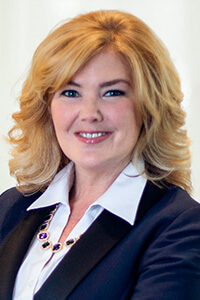
(Illustrations by Liam Eisenberg)
When protesters jumped onto the stage during the 2022 Fall Meeting of the American Geophysical Union (AGU) at Chicago’s McCormick Place, they unfurled a banner as a way to draw attention to the climate crisis. Although the incident was not violent, it “turned into a really difficult issue” for the organization of Earth and planetary scientists.
“We fully agree that there should be more urgency around climate change,” Lauren Parr, AGU’s senior vice president, meetings and learning, told Convene. “I mean, you had us at ‘hello’ with that, but you can’t charge a plenary stage and take over the session to make your case. We can agree with your message but if your actions frighten people and make them feel unsafe, as a real or perceived threat, that presents an enormous challenge.

Find a facsimile of the print version of this Sept./Oct. 2023 cover and CMP Series story in our digital edition.
“When we think about protesters,” Parr said, we also have to consider who they may silence. The two protesters at the meeting, which attracted more than 23,700 in-person and online registrants, “effectively silenced our first transgender plenary convener and speaker, a scientist, artist, and activist in her own right,” she said. “And they disrupted artists who were about to come on stage [to perform] and who were using their work to inspire discussions on climate change. While the session continued after we were able to remove the protesters from the stage, the focus shifted to them. No one talks about the great work by the convener and artists. They remember the disruption, and that’s really unfortunate.”
While Parr thinks there’s an increased level of stress among people making it more difficult for them to behave in a polite and civil manner in general, she doesn’t underestimate the level of anxiety felt by her particular audience. “I do think that in climate science in particular, you are seeing people get more and more frustrated and frightened.
There is real grief expressed by members of the community,” she said. To help people deal with that angst at this year’s AGU Annual Meeting in San Francisco, Dec. 11–15, “we’re having experts facilitate workshops on climate grief and resilience to help our community learn and cope in a productive way. We wanted to respect these feelings and offer tangible resources.”
What concerns Parr is how the association community in general can respond to a more charged environment. “If we’re spending more and more on security, we’re spending less on F&B, or our registration rates are going up. How are we creating those safe spaces and holding affordable conferences that people can attend?”
RELATED: Events and Venues Face New Challenges to Safety, Security
While she doesn’t (yet) have an answer to that question, Parr made the following recommendations for organizers who need to plan for the prospect of attracting protesters at their events:

Lauren Parr
Determine your protocols, your duty of care, and get internal consensus when it comes to protests or disruptions. Do you ask disrupters to leave the stage and if they refuse, do you shut the session down? Do you have the AV company stop recording if the session is being streamed? Your leadership should approve or help create these policies and understand their duty of care for attendees at your event.
Make your code of conduct “unskippable.” AGU is making sure registrants spend more time reading their code of conduct than just having them check a box at the end. “You’re going to have to click specific boxes to say that you understand the behavior that’s required,” Parr said, and on site, there will be signs about the code of conduct posted.
Rethink your staging to make it safer. “We’ve raised our central stage,” Parr said. It used to be two feet high to make it more “democratic” and “engaging,” but “we’ve raised that up to four or four-and-a-half feet and you won’t be able to come on and off the stage from the sides. You’ll have to come from back of the house for our main stage.”
Have a backup plan if someone disrupts a session or causes safety concerns. Partner with your venue to understand how they handle safety, emergency response, disruptions, and protests as you are responsible for following their policies and procedures as well. If there is an escalation, decisions will largely be driven by the venue and local authorities despite policies you may have in place. “Understand where that line is,” she said.
Expect that certain speakers will require expensive security measures. Government or high-profile speakers, Parr said, want to know what security measures you have in place. “I think you’re going to see very high-level speakers require more in terms of security,” she said, “and there’s a cost to that.”
Offer would-be protesters or disrupters ways to gather and share ideas. Any member of our community can apply for a session, town hall, open space, or designated protest space, Parr said. “You can’t disrupt sessions, take over events — there are both building and organizational policies to keep people safe,” she said, “but we are happy to help you convene. Educate your attendees on what they can do to engage and express themselves within these policies. If people want to protest, we’re not here to stop them. But we are here to say that anything that happens at our event needs to occur within the boundaries of our Code of Conduct and be respectful of everyone. You can’t scare people.”
Michelle Russell is editor in chief of Convene.
